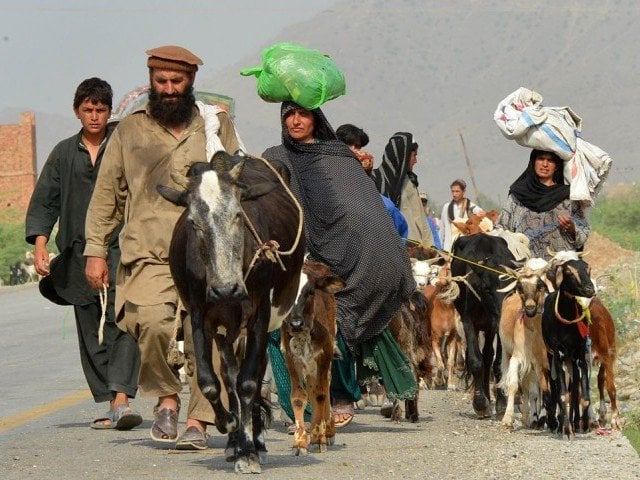
ISLAMABAD: Federally Administered Tribal Areas (Fata) has been a hotbed of militant violence for more than a decade. The backwardness of the education in the area – where the literacy rate is the lowest and militants have often targeted educational facilities –has often been attributed to this turmoil.
However, an official report compiled by Fata Secretariat exposes mismanagement and criminal negligence of successive regimes as the major source of Fata’s backwardness. According to the report, the area has the highest ratio of schools in the country but the lowest literacy rate.
Knocking on doors: Ad hoc lecturers in FATA demand job security

The report makes some startling revelations. Despite all the destruction in Fata, it has one school for an average population of 812 persons. This ratio of schools, many of which merely exist on papers, is the highest as compared to the Khyber Pakhtunkhwa (K-P) and the country in general.
In Fata for a population of 4,523,782 people, there are a total of 5,572 government educational institutions – including 4,677 primary, 544 middle, 335 high and 16 higher secondary schools. In the K-P, there is one school for a population of 875, while there is one school for a population of 1,195 in the rest of the country.
Fata Development Indicator Household Survey 2013-2014 – carried out by the Bureau of Statistics – said the overall literacy rate in Fata is 33.3 per cent, which is far less than the national average of 58 per cent.
The future of FATA
Similarly, the adult literacy rate in Fata is 28.4 per cent as compared to 57 per cent adult literacy rate in the rest of the country. The survey also reveals a marked gender gap in literacy. Male adult literacy rate in Fata is 45 per cent whereas the female adult literacy rate is merely 7.8 per cent.
The dropout rate is also the highest in Fata. Official figures say of the students who get enrolled, 70 per cent boys and 77 per cent girls drop out before completing their primary education. Among those who make it to the secondary level, 41 per cent boys and 42 per cent girls leave education before matriculation.
At least 44.2 per cent children in Fata have never got enrolled in any school despite the fact that the average distance from a house to an education institution is 1.8 kilometre.
Just like the ratio of number of schools, the area has also one of the best students-teachers ratio. There is one teacher on average of 49 male and 45 female students at primary level. For the middle classes, there is one teacher each for seven male and seven female students. Meanwhile, there is one teacher for 14 boys and 15 girls in the high schools.
The existing infrastructure and teachers’ strength can easily cater for out of school kids in the area that are around 182,405 – among them 9,1493 are male and 90,922 are female.
Interestingly, in many cases schools were constructed in areas where there was no need.
Now Fata Secretariat has decided to close down 400 of these schools, where the number of students is less than 40. Among these, 330 schools are for boys while 70 are for girls.
Talking to The Express Tribune, Senator Taj Afridi – who represents Fata in the Upper House – accepted that in the tribal areas, the ratio of schools vs population is better than any other region of the country.
Different strokes: FATA reforms, FCR polarise tribespeople
“During a recent briefing, officials of Fata Secretariat told us that Rs2 million is the average cost the national kitty bears in Fata for every student enrolled in the high classes. I think this is the highest spending even by standards of developed countries,” he said.
The senator disagreed with the notion that militancy is the main reason for backwardness of the area.
“Though some schools were affected due to militancy, most of the infrastructure remains intact. We have buildings, students, teachers, education offices, but no working environment,” he said.
He said the schools, destroyed or damaged by militants were not more than 5 per cent of the total institutions of the area. Even at the peak of militancy, teachers and staff of education department continued to get their salaries regularly.
“Even today there is no shortage of school buildings in any part of Fata. On papers we have everything. We are allocated money for all the services – be it heath, education, civic facilities, you name any department which exists in any other part of country and it does not have presence in Fata.”
“But on ground you would see nothing. All this money goes in waste in mismanagement and corruption,” he added.
He said Fata has been made a hub of corruption. “The menace is rampant and wide spread. You would hardly find any government department functional despite tall claims of successive regimes on development projects.”
Taj Afridi said Fata faced many problems. “But educational poverty supersedes all of them. It takes back Fata to dark ages and this is resulting in taking back Pakistan to medieval times,” he added.
Published in The Express Tribune, January 18th, 2016.


































































COMMENTS (1)
Comments are moderated and generally will be posted if they are on-topic and not abusive.
For more information, please see our Comments FAQ